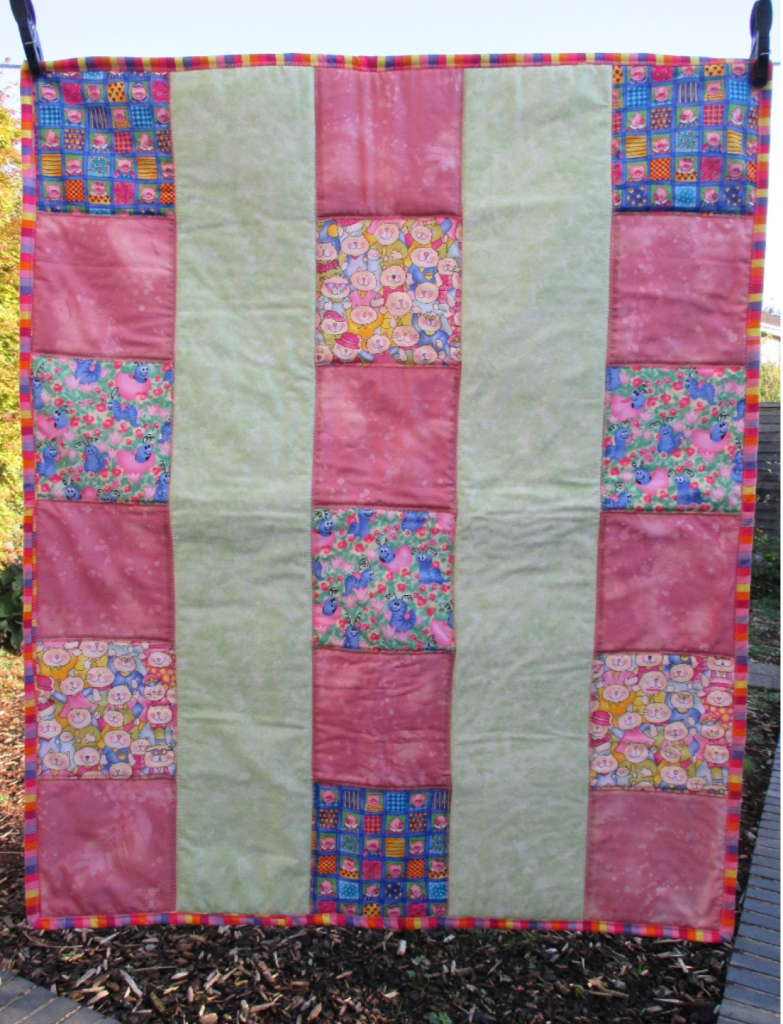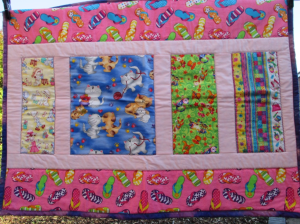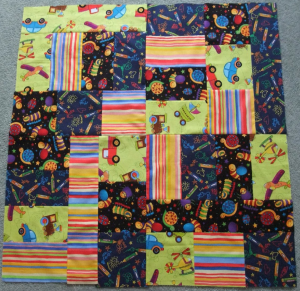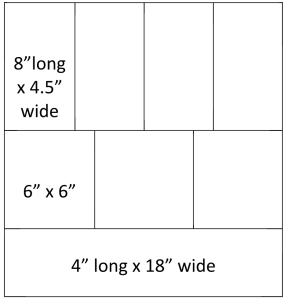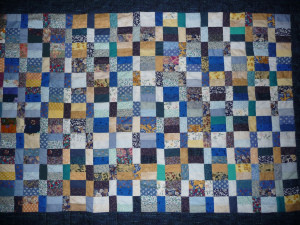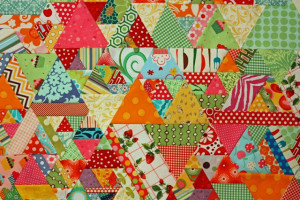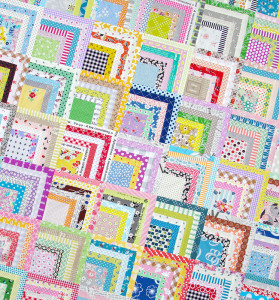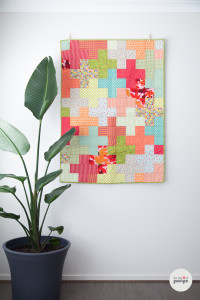Lyn | News from HQ
March and April were busy months. We had a presence on the Quilters’ Guild stand at the Knitting and Stitching Show at Olympia. They were running beginners workshops showing people how to make a simple block and then how different colour schemes and arrangements produced different quilts from the same basic shape. Liz Powderham from Surrey provided a display of Linus quilts so that visitors could see just how effective a simple block can be and how much pleasure it can bring to a sick or distressed child.
In April there were two events taking place on the same weekend. There was the Quilt Village at Uttoxeter and also the Quilters’ Guild AGM in Harrogate. Celia Wright, Helen Scales and Heather Russell manned the stand at Uttoxeter and sold scraps, bags and old magazines to raise funds as well as telling people about our work. I went to Harrogate where we had some sewing machines at the AGM – helpers put together 13 tops from the blocks made at Olympia, and started on some more packs.
Now I just need to catch up with the paperwork that has been piling up while I was preparing for the shows and driving across the country to go to them!
Betty | Londonderry
At the Creative Crafts Belfast we raffled quilts and made £320.00 as well as giving out 400 leaflets about Project Linus and 700 free knitting patterns. We had a great response and met a lot of ladies who had never heard of Linus and also met one potential coordinator. I was given 30 little knitted blankets which I have passed on to Craigavon Area Hospital and met a lot of nurses who want us to make incubator covers etc. I was also given a donation of £500 from Northern Ireland Children’s Cancer fund to make quilts for them. I am also doing a banner for them to put up in the hospital. So we are keeping busy over here!
Joan | Dumfries & Galloway
Yesterday, the “Sorbie Stitchers”, a wee group in a nearby village, who meet weekly in someone’s kitchen, and who are giving so many quilts, held a wonderful soup and sweet lunch (with raffle) and raised £465 for their own funds to buy fabric, fleece etc. The room was decorated with quilts, and as well as leaflets on the tables, their leader spoke to all to thank them for coming and spoke of the work of Project Linus. As a WPC she has first-hand knowledge of how much the quilts mean to the children – and the families. There was one wee girl there, enjoying lunch who had received a quilt. I was just there as a question/answer-er, and dogs body!
Marion | Barnsley and North Sheffield
We delivered 64 quilts to Barnsley Hospital’s neonatal unit yesterday that had been made by a group of women doing a quilt-a-thon for red nose day. In addition to making the quilts for Linus they raised £2000 for children in need. An excellent result all round.
Pip | Edinburgh
A couple of thank you letters:
“Ladies: my son was in the sick kids in October, and he received a lovely quilt from your project. It is lovely and we use it often. Many people admire it. My son is doing well and is now 9 months. I am sorry it took me so long to get in touch to say Thank You – Many thanks, you are all very talented and very kind.”
“I would like to say a huge thank you for the beautiful blanket my son received when he was in hospital in January. My son Alexander (aged 3) came down with Scarlet Fever and pneumonia and had to stay in hospital for twelve days. It was a horrible experience but the hospital were amazing and Alexander was really brave. He got his blanket about five days into his stay and has held onto it ever since. He loves the planets that glow in the dark and the soft furry side. He has been using it to wrap up his favourite soft toy ‘Little Doggy’ ever since and has it on his bed at night.
Alex has fully recovered now and you would not know he had been dangerously ill. Thank you for such a beautiful and kind gift. The blanket has become a symbol for me of all the kindness, goodness and love people have. Many thanks and all the best with all your future blanket making.”
Ann | Chesterfield & South Sheffield
Don’t you just love a challenge! The sister of a member of sew4others in Dronfield runs a printing business selling personalised pillowcases made from 100% soft cotton and just the right size for baby quilts and gives us the surplus. We enjoyed planning, designing and cutting up the pillowcases to make baby quilts. The finished quilts have now been donated to Chesterfield Neo-Natal unit.
Jacki | Gloucester
My first sensory quilt! Corduroy, fur, fleece and towelling. All washable. Of course. I only sent it to show off as I’m really pleased with it. I made my husband close his eyes to ‘see it’ and he thought the different textures and shapes worked well. Mind you, what does he know? The odd crazy pieces are surprisingly good as the texture of the seams is great. I think other branches of SENSE would be interested too.
Ingrid | Pembrokeshire
A lovely letter from Nora, a former coordinator in Pembrokeshire:
“I first heard about Project Linus in the autumn of 2002. As there was no local coordinator I became a volunteer and set about making quilts and enlisting friends to make some too. I handed over the coordinating side of things after about four years and concentrated on making more quilts.
After a few years I realised what a splendid excuse it was to try out yet another idea. Amish designs in wild colours, or how many different layouts were possible using just nine-patch blocks or friendship stars. My local group were very good at supporting me by buying wadding: other people gave me fabric for piecing and backing. I have always tried to keep photos of all the quilts I made and recently I realised that not only was I averaging 40 a year but must be approaching a total of 500! Having recently moved into a much smaller house with a very small workroom it seemed like a good time to wind down once that total was reached.
Nora Squibbs”
Caroline | Liverpool
Last year Liverpool Project Linus put out an appeal via Radio Merseyside for shirts to make into quilts. We were contacted by Joan, whose late husband loved buying shirts: she’d been loathe to part with them until she heard about Project Linus, and liked the idea of them being used to cheer up children.
Two volunteers cut the shirts into squares and we held a sew-in at The Button Boutique where quilts were created. In April 2015 these were displayed at Liverpool Central Library in an exhibition entitled “62 shirts – in memory of Pat” and Joan was our guest of honour.
Get in touch
Please send any articles or photographs for inclusion in the next newsletter to Ann.
